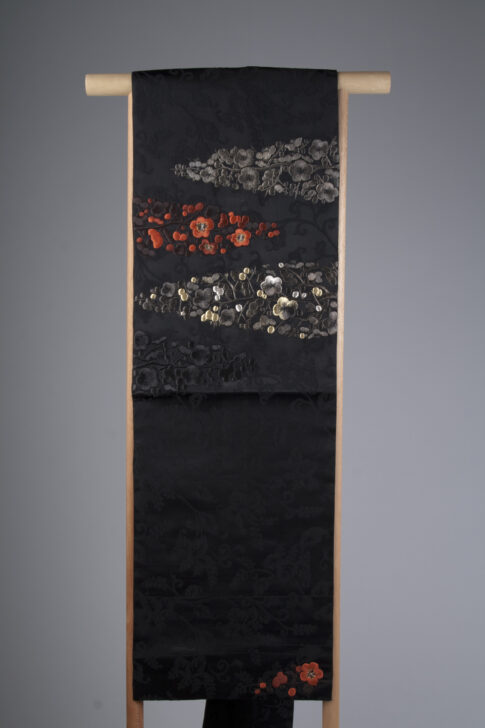Black Nagoya-style obi in sateen weave (shusu) with embroidered plum blossom designs
Japanese

Description
Black Nagoya-style obi with embroidered plum blossom designs
---
Nagoya obi
Japan, Showa period (1926–1989)
1930s–50s
Black silk with gold- and silver-wrapped thread
Gift of Howard and Patricia Yamaguchi, 2005/1.343
Nagoya obi
Japan, Showa period (1926–1989)
1960s
Black silk damask with metallic thread embroidery
Gift of Howard and Patricia Yamaguchi, 2005/1.330
Takizawa Kôyû
Japan, active 1940–1960
Nagoya obi
Showa period (1926–1989)
circa 1940–60
Tamaito (dupioni) silk with hand-painted landscape design
Gift of Howard and Patricia Yamaguchi, 2005/1.332
Nagoya obi*
Japan, Showa period (1926–1989)
1930s–50s
Silk damask with woven pattern and metallic thread embroidery
Gift of Howard and Patricia Yamaguchi, 2005/1.331
Obi
Japan, Showa period (1926–1989)
1940s–50s
Silk with Saga brocade appliqués
Gift of Howard and Patricia Yamaguchi, 2005/1.335
On kimono, Saga brocade appliqués seem almost like delicately painted designs. The poems on the fan-shaped Saga brocades of this pink-grey obi were specially commissioned from a professional calligrapher by Iwata Shizuka; they allude to a long tradition of applying calligraphy directly to kimono during the Edo period (1615–1868).
Because of its origin as a pastime for the ladies-in-waiting of the Nabeshima clan, Saga brocade continues to be practiced today by women of upper-class families. Soon after she married in 1950, Iwata Shizuko took a class to learn the Saga brocade weaving technique. Both she and her mother liked the understated, elegant beauty of Saga brocade.
*Pictured obi
(Wrapped in Silk & Gold Exhibition, Summer 2010)
Subject Matter:
Nagoya obi were first produced at the end of the Taisho era, and are simpler than the more formal fukuro and maru obi. A portion of Nagoya obi fabric is folded and stitched in half, making it easier to tie. This is possibly a 1930s fukuro obi resewn into Nagoya style in 1970s.
Physical Description:
Black silk damask with interwoven paulownia pattern; plum blossoms embroidered in solver, gold, and gunmetal gray metallic threads, and persimmon, brown, and black silk threads.
Usage Rights:
If you are interested in using an image for a publication, please visit https://umma.umich.edu/request-image/ for more information and to fill out the online Image Rights and Reproductions Request Form.